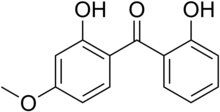
| |
| Names | |
|---|---|
| Preferred IUPAC name
(2-Hydroxy-4-methoxyphenyl)(2-hydroxyphenyl)methanone | |
| Other names
Dioxybenzone
benzophenone-8 | |
| Identifiers | |
3D model (JSmol)
|
|
| ChEMBL | |
| ChemSpider | |
| ECHA InfoCard | 100.004.571 |
| KEGG | |
PubChem CID
|
|
| UNII | |
CompTox Dashboard (EPA)
|
|
| |
| |
| Properties | |
| C14H12O4 | |
| Molar mass | 244.25 g/mol |
| Density | 1.38 g/cm3 |
| Melting point | 68 °C (154 °F; 341 K) |
| Boiling point | 170 to 175 °C (338 to 347 °F; 443 to 448 K) |
Except where otherwise noted, data are given for materials in their standard state (at 25 °C [77 °F], 100 kPa).
| |
Dioxybenzone (benzophenone-8) is an organic compound used in sunscreen to block UVB and short-wave UVA (ultraviolet) rays.[2] It is a derivative of benzophenone. It is a yellow powder with a melting point of 68 °C. It is insoluble in water, but moderately soluble in ethanol and isopropanol.
References
[edit]- ^ Merck Index, 12th Edition, 3357.
- ^ The Skin Cancer Foundation: Understanding UVA and UVB
Well, that’s interesting to know that Psilotum nudum are known as whisk ferns. Psilotum nudum is the commoner species of the two. While the P. flaccidum is a rare species and is found in the tropical islands. Both the species are usually epiphytic in habit and grow upon tree ferns. These species may also be terrestrial and grow in humus or in the crevices of the rocks.
View the detailed Guide of Psilotum nudum: Detailed Study Of Psilotum Nudum (Whisk Fern), Classification, Anatomy, Reproduction